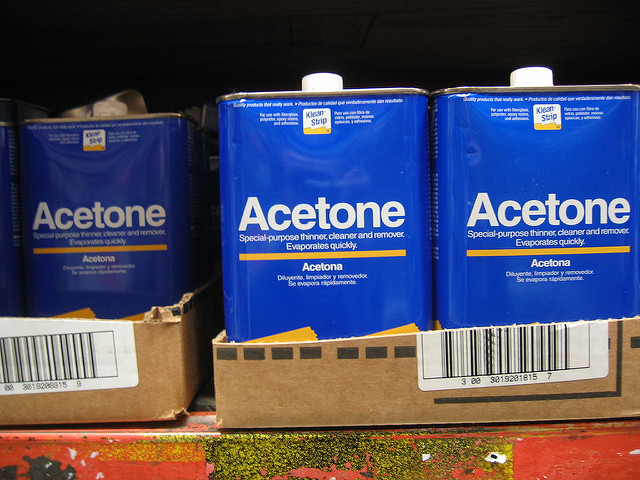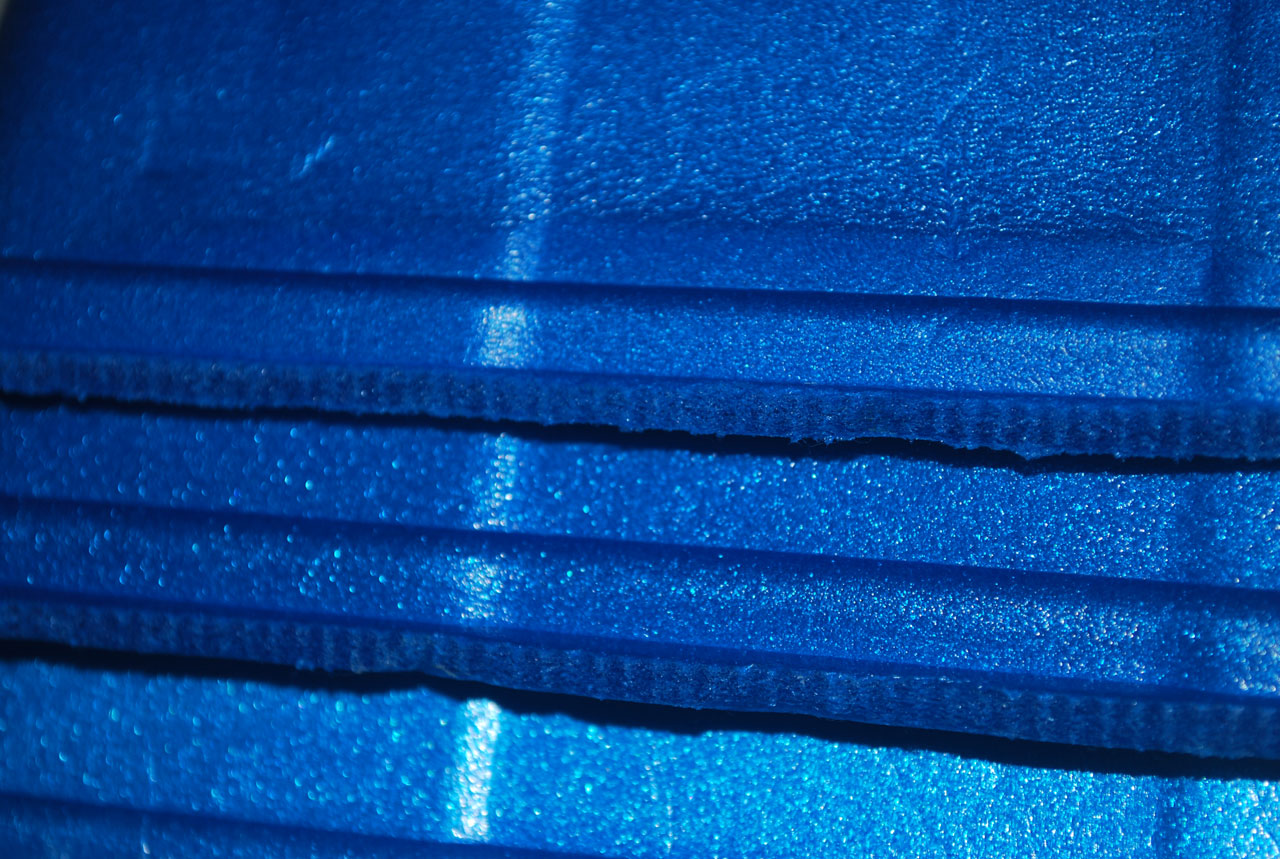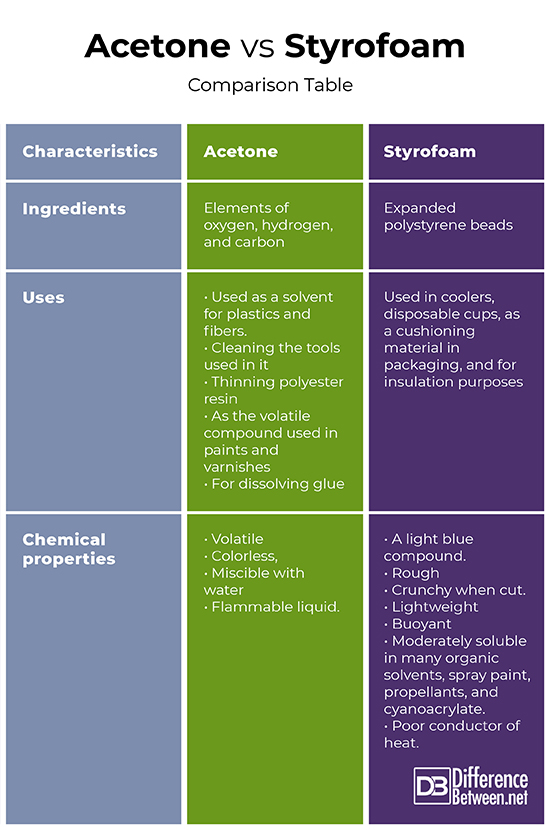Difference Between Acetone and Styrofoam
Do you know that you can dissolve Styrofoam into Acetone?
Styrofoam is made of polystyrene foam and polystyrene can dissolve in acetone, and when it does, the air in the foam is released. This makes it appear like you are dissolving a massive quantity of material into a small volume of liquid. Pretty cool ! Isn’t it?

What is Acetone?
Acetone, also called propane is an organic compound denoted using the formula (CH3)2CO. It is regarded as the smallest and simplest ketone and serves as one of the most important solvents for such purposes as laboratories cleaning needs.
Chemical Properties of Acetone
Acetone is listed as:
- Volatile
- Colorless
- Miscible with water and
- A flammable liquid.
Uses of Acetone
Acetone is widely used:
- As a solvent.
- In the production of methyl methacrylate.
- Production of bisphenol A.
- Household uses including as an active ingredient used as a paint thinner and nail polish remover.
Environmental Effects
When Acetone is released to the environment, it can cause significant risks of oxygen depletion.

What is Styrofoam?
Styrofoam is a type of expanded polystyrene mainly produced to be used to make food containers. It is manufactured as foam and is mostly used as building insulation for roofs, walls, and foundations. Here, it is used as a water barrier and thermal insulator.
Chemical Properties of Styrofoam
Styrofoam is produced as:
- A light blue compound.
- Rough
- Crunchy when cut.
- Lightweight
- Buoyant
- Moderately soluble in many organic solvents, spray paint, propellants, and cyanoacrylate.
- Poor conductor of heat.
Uses of Styrofoam
Styrofoam is mostly used for:
- As a building insulator.
- Preventing soil disturbance under roads as well as other constructions when it’s freezing or thawing.
Environmental Effects
Styrofoam is highly regarded as a possible human carcinogen due to its styrene quantities.
Difference Between Acetone and Styrofoam
Definition
Acetone is defined as an organic compound denoted with the formula (CH3)2CO. It is a colorless a flammable solvent that easily mixes with water and quickly evaporates into the air.
Styrofoam, on the other hand, is a polystyrene foam, (a polymer), that is produced from long chains of molecules. For it to become lightweight, it injected with gases at the manufacturing stage and exposed to about 95 percent of air.
Ingredients
Acetone is made up of a molecular composition denoted as (CH3)2CO while the condensed structural format is OC(CH3)2. As such, Acetone is produced by combining elements of oxygen, hydrogen, and carbon.
Styrofoam, on the other hand, is produced from expanded polystyrene beads.
Uses
Acetone is mainly used as a solvent for fibers and plastics. It is also used for cleaning the tools used with it, thinning polyester resin, as one of the volatile components found in varnishes and paints, and for dissolving superglue and two-part epoxies.
Styrofoam, on the other hand, is used in coolers, disposable cups, as well as for cushioning materials during packaging. It is also used for insulation purposes.
Acetone Vs. Styrofoam: Comparison Table

Summary of Acetone Vs. Styrofoam
In the field of Organic Chemistry, there can be a never-ending count of compounds. All of the compounds exist differently, and their uses differ too. Also, their chemical properties are specific to each which makes them distinct from one another. The same cases apply to both Acetone and Styrofoam with each possessing distinct chemical properties, ingredients, uses, and well as existence.
- Difference Between Minecraft and Terraria - August 7, 2020
- Difference Between Alliteration and Onomatopoeia Poems - July 25, 2019
- Difference Between Certification and Licensure - July 24, 2019
Search DifferenceBetween.net :
 Email This Post
: If you like this article or our site. Please spread the word. Share it with your friends/family.
Email This Post
: If you like this article or our site. Please spread the word. Share it with your friends/family.
1 Comment
Leave a Response
References :
[0]Ingredients In Acetone. 2019, https://www.hunker.com/12539719/ingredients-in-acetone. Accessed 1 Feb 2019.
[1]Williams, Sebastian, and Sebastian Williams. "What Do Styrofoam Cups And Construction Material Have In Common?". Polymolding LLC, 2019, http://polymoldingllc.com/what-do-styrofoam-cups-and-construction-material-have-in-common/.
[2]Image credit: https://www.flickr.com/photos/pheezy/83658850
[3]Image credit: https://www.publicdomainpictures.net/en/view-image.php?image=7133&picture=blue-styrofoam


Acetone is NOT also called ‘propane’, but ‘propanone’, a very significant difference to an organic chemist. Please be accurate when attempting to write about technical subjects.